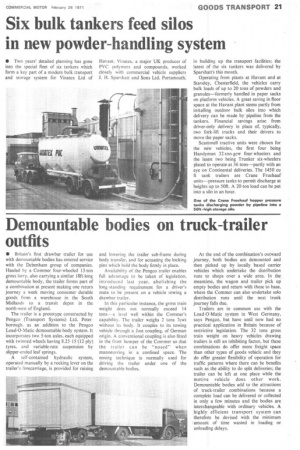Demountable bodies on truck-trailer outfits
Page 23

If you've noticed an error in this article please click here to report it so we can fix it.
• Britain's first drawbar trailer for use with demountable bodies has entered service with the Debenham group of companies. Hauled by a Commer four-wheeled 13-ton gross lorry, also carrying a similar 18ft-long demountable body, the trailer forms part of a combination at present making one return journey a week moving consumer durable goods from a warehouse in the South Midlands to a transit depot in the north-west of England.
The trailer is a prototype constructed by Pengco (Transport Systems) Ltd, Peterborough. as an addition to the Pengco Load-O-Matic demountable-body system. It incorporates two 5-ton axles, each equipped with twinned wheels having 8.25-15 (12-ply) tyres, and variable-rate suspension by slipper-ended leaf springs.
A self-contained hydraulic system, operated manually by a rocking lever on the trailer's forecarriage, is provided for raising and lowering the trailer sub-frame during body transfer, and for actuating the locking pins which hold the body firmly in place.
Availability of the Pengco trailer enables full advantage to be taken of legislation, introduced last year, abolishing the long -standing requirement for a driver's mate to be present on a vehicle towing a drawbar trailer.
In this particular instance, the gross train weight does not normally exceed 14 tons----a level well within the Commer's capability. The trailer weighs 2 tons 7cwt without its body. It couples to its towing vehicle through a Jost coupling, of German origin. A conventional coupling is also fitted in the front bumper of the Commer so that the trailer can be "nosed" when manoeuvring in a confined space. The nosing technique is normally used for driving the trailer under one of the demountable bodies.
At the end of the combination's outward journey, both bodies are demounted and then picked up by locally based carrier vehicles which undertake the distribution runs to shops over a wide area. In the meantime, the wagon and trailer pick up empty bodies and return with these to base, where the Commer can also undertake solo distribution runs until the next trunk journey falls due.
Trailers are in common use with the Load-O-Matic system in West Germany, says Pengco, but have until now had no practical application in Britain because of restrictive legislation. The 32 tons gross train weight on heavy vehicles drawing trailers is still an inhibiting factor, but these combinations do offer more freight space than other types of goods vehicle and they do offer greater flexibility of operation for traffic patterns where there can be benefits such as the ability to do split deliveries; the trailer can be left at one place while the motive vehicle does other work. Demonntable bodies add to the attractions of tru4-trailer combinations because a complete load can be delivered or collected in oribi a few minutes and the bodies are interchangeable with ordinary vehicles. A .highly efficient transport system can therefore be devised with the minimum :amount of time wasted in loading • or unloading delays.




























































































